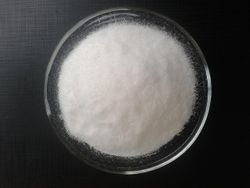Difference between revisions of "Ammonium dihydrogen phosphate"
Diachrynic (Talk | contribs) |
|||
| Line 66: | Line 66: | ||
| pKb = | | pKb = | ||
| Solubility = 40.4 g/100 mL | | Solubility = 40.4 g/100 mL | ||
| − | | SolubleOther = Insoluble in [[ethanol]]<ref>D. Xu, X. Xiong, L. Yang, Z. Zhang, X. Wang, ''J. Chem. Eng. Data'' '''2016''', 61, 1, 78–82, [https://doi.org/10.1021/acs.jced.5b00224 https://doi.org/10.1021/acs.jced.5b00224]</ref> | + | | SolubleOther = Insoluble in [[acetone]], [[ethanol]]<ref>D. Xu, X. Xiong, L. Yang, Z. Zhang, X. Wang, ''J. Chem. Eng. Data'' '''2016''', 61, 1, 78–82, [https://doi.org/10.1021/acs.jced.5b00224 https://doi.org/10.1021/acs.jced.5b00224]</ref>, hydrocarbons |
| Solvent = | | Solvent = | ||
| Taste = Salty | | Taste = Salty | ||
| Line 125: | Line 125: | ||
==Preparation== | ==Preparation== | ||
| − | Ammonium dihydrogen phosphate can be made by reacting [[ammonium bicarbonate]] or [[ammonium carbonate]] with phosphoric acid, | + | Ammonium dihydrogen phosphate can be made by reacting [[ammonium bicarbonate]] or [[ammonium carbonate]] with [[phosphoric acid]], in the following molar ratio: |
: NH<sub>4</sub>HCO<sub>3</sub> + H<sub>3</sub>PO<sub>4</sub> → NH<sub>4</sub>H<sub>2</sub>PO<sub>4</sub> + H<sub>2</sub>O + CO<sub>2</sub> | : NH<sub>4</sub>HCO<sub>3</sub> + H<sub>3</sub>PO<sub>4</sub> → NH<sub>4</sub>H<sub>2</sub>PO<sub>4</sub> + H<sub>2</sub>O + CO<sub>2</sub> | ||
Latest revision as of 15:25, 1 October 2024
 Agricultural MAP sample
| |
| Names | |
|---|---|
| IUPAC name
Ammonium dihydrogen phosphate
| |
| Other names
Monoammonium phosphate
MAP | |
| Identifiers | |
| Jmol-3D images | Image |
| |
| Properties | |
| H6NO4P NH4H2PO4 | |
| Molar mass | 115.02 g/mol |
| Appearance | Crystalline white solid |
| Odor | Odorless |
| Density | 1.80 g/cm3 |
| Melting point | 190 °C (374 °F; 463 K) |
| Boiling point | Decomposes |
| 40.4 g/100 mL | |
| Solubility | Insoluble in acetone, ethanol[1], hydrocarbons |
| Vapor pressure | ~0 mmHg |
| Thermochemistry | |
| Std enthalpy of
formation (ΔfH |
−1445.07 kJ/mol |
| Hazards | |
| Safety data sheet | Fisher Scientific |
| Flash point | Non-flammable |
| Lethal dose or concentration (LD, LC): | |
| LD50 (Median dose)
|
5750 mg/kg (rat, oral) |
| Related compounds | |
| Related compounds
|
Phosphoric acid |
| Except where otherwise noted, data are given for materials in their standard state (at 25 °C [77 °F], 100 kPa). | |
| Infobox references | |
Ammonium dihydrogen phosphate (ADP), more commonly known as monoammonium phosphate (MAP), is an inorganic chemical compound with the formula NH4H2PO4, mainly used as a fertilizer.
Contents
Properties
Chemical
MAP will decompose when heated to yield water and ammonia vapors, leaving behind polyphosphoric acid residue.
Physical
MAP is a crystalline white solid, soluble in water and alcohol. It has a density of 1.80 g/cm3.
Availability
Ammonium dihydrogen phosphate is sold as fertilizer, and it's fairly pure, though oneu can increase its purity via recrystallization.
It is also available as the main component of dry powder fire extinguishers.
Preparation
Ammonium dihydrogen phosphate can be made by reacting ammonium bicarbonate or ammonium carbonate with phosphoric acid, in the following molar ratio:
- NH4HCO3 + H3PO4 → NH4H2PO4 + H2O + CO2
- (NH4)2CO3 + 2 H3PO4 → 2 NH4H2PO4 + 2 H2O + 2 CO2
Projects
- Grow large crystals
- Make piezoelectric crystals
- Make ammonia
- Make calcium phosphate
Handling
Safety
MAP is safe to handle and has little toxicity. It is not flammable.
Storage
MAP should be stored in closed bottles, plastic bottles are cheap.
Disposal
MAP has low toxicity, and can be dumped in the ground as fertilizer or poured down the drain.
References
- ↑ D. Xu, X. Xiong, L. Yang, Z. Zhang, X. Wang, J. Chem. Eng. Data 2016, 61, 1, 78–82, https://doi.org/10.1021/acs.jced.5b00224
Relevant Sciencemadness threads
- Chemical pages without CAS Registry Number
- Articles without EBI source
- Chemical pages without ChemSpiderID
- Chemical pages without DrugBank identifier
- Articles without KEGG source
- Articles without InChI source
- Articles without UNII source
- Articles containing unverified chemical infoboxes
- Chemical compounds
- Inorganic compounds
- Ammonium compounds
- Phosphates
- Readily available chemicals